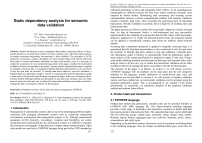Static dependency analysis for semantic data validation
Автор: Ilyin D.V., Fokina N.Yu., Semenov V.A.
Журнал: Труды Института системного программирования РАН @trudy-isp-ran
Статья в выпуске: 3 т.30, 2018 года.
Бесплатный доступ
Modern information systems manipulate data models containing millions of items, and the tendency is to make these models even more complex. One of the most crucial aspects of modern concurrent engineering environments is their reliability. The principles of ACID (atomicity, consistency, isolation, durability) are aimed at providing it, but directly following them leads to serious performance drawbacks on large-scale models, since it is necessary to control the correctness of every performed transaction. In the paper, a method for incremental validation of object-oriented data is presented. Assuming that a submitted transaction is applied to originally consistent data, it is guaranteed that the final data representation is also consistent if only the spot rules are satisfied. To identify data items subject to spot rule validation, a bipartite data-rule dependency graph is formed. To automatically build the dependency graph a static analysis of the model specifications is proposed to apply. In the case of complex object-oriented models defining hundreds and thousands of data types and semantic rules, the static analysis seems to be the only way to realize the incremental validation and to make possible to manage the data in accordance with the ACID principles.
Information systems, acid, data consistency management, express
Короткий адрес: https://sciup.org/14916544
IDR: 14916544 | DOI: 10.15514/ISPRAS-2018-30(3)-19
Список литературы Static dependency analysis for semantic data validation
- V.A. Semenov. Product Data Management with Solid Transactional Guarantees, In Transdisciplinary Engineering: A Paradigm Shift Series Advances in Transdisciplinary Engineering, IOS Press, 2017, pp. 592-599.
- L. Lämmer and M. Theiss. Product Lifecycle Management, In Concurrent Engineering in the 21st Century -Foundations, Developments and Challenges, Springer, 2015, pp. 455-490.
- J. Osborn. Survey of concurrent engineering environments and the application of best practices towards the development of a multiple industry, multiple domain environment. Clemson University, 2009. Accessed: 29/01/2018. Available: http://tigerprints.clemson.edu/all_theses/635/
- M. Philpotts. An introduction to the concepts, benefits and terminology of product data management, Industrial Management & Data Systems, MCB University Press, vol. 96, no. 4, 1996, pp. 11-17.
- X. Blanc, A. Mougenot, I. Mounier, T. Mens. Incremental Detection of Model Inconsistencies based on Model Operations. In Advanced Information Systems Engineering, CAiSE 2009, LNCS, vol. 5565, Springer, 2009, pp. 32-46.
- C. Xu, C.S. Cheung, W.K. Chan. Incremental Consistency Checking for Pervasive Context. In Proc. the 28th International Conference on Software Engineering, 2006, pp. 292-301.
- J. Harrison, S.W. Dietrich. Towards an Incremental Condition Evaluation Strategy for Active Deductive Databases. In Research and Practical Issues in Databases, World Scientific, 1992, pp. 81-95.
- ISO 10303-11: 2004. Industrial automation systems and integration -Product data representation and exchange -Part 11: Description methods: The EXPRESS language reference manual, ISO, 2004.


